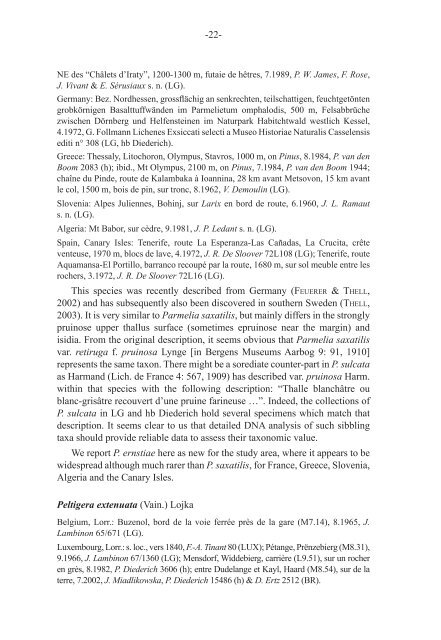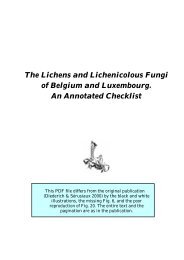LEJEUNIA - Lichens of Belgium, Luxembourg and northern France
LEJEUNIA - Lichens of Belgium, Luxembourg and northern France
LEJEUNIA - Lichens of Belgium, Luxembourg and northern France
Create successful ePaper yourself
Turn your PDF publications into a flip-book with our unique Google optimized e-Paper software.
-22-<br />
NE des “Châlets d’Iraty”, 1200-1300 m, futaie de hêtres, 7.1989, P. W. James, F. Rose,<br />
J. Vivant & E. Sérusiaux s. n. (LG).<br />
Germany: Bez. Nordhessen, grossflächig an senkrechten, teilschattigen, feuchtgetönten<br />
grobkörnigen Basalttuffwänden im Parmelietum omphalodis, 500 m, Felsabbrüche<br />
zwischen Dörnberg und Helfensteinen im Naturpark Habitchtwald westlich Kessel,<br />
4.1972, G. Follmann Lichenes Exsiccati selecti a Museo Historiae Naturalis Casselensis<br />
editi n° 308 (LG, hb Diederich).<br />
Greece: Thessaly, Litochoron, Olympus, Stavros, 1000 m, on Pinus, 8.1984, P. van den<br />
Boom 2083 (h); ibid., Mt Olympus, 2100 m, on Pinus, 7.1984, P. van den Boom 1944;<br />
chaîne du Pinde, route de Kalambaka à Ioannina, 28 km avant Metsovon, 15 km avant<br />
le col, 1500 m, bois de pin, sur tronc, 8.1962, V. Demoulin (LG).<br />
Slovenia: Alpes Juliennes, Bohinj, sur Larix en bord de route, 6.1960, J. L. Ramaut<br />
s. n. (LG).<br />
Algeria: Mt Babor, sur cèdre, 9.1981, J. P. Ledant s. n. (LG).<br />
Spain, Canary Isles: Tenerife, route La Esperanza-Las Cañadas, La Crucita, crête<br />
venteuse, 1970 m, blocs de lave, 4.1972, J. R. De Sloover 72L108 (LG); Tenerife, route<br />
Aquamansa-El Portillo, barranco recoupé par la route, 1680 m, sur sol meuble entre les<br />
rochers, 3.1972, J. R. De Sloover 72L16 (LG).<br />
This species was recently described from Germany (FEUERER & THELL,<br />
2002) <strong>and</strong> has subsequently also been discovered in southern Sweden (THELL,<br />
2003). It is very similar to Parmelia saxatilis, but mainly differs in the strongly<br />
pruinose upper thallus surface (sometimes epruinose near the margin) <strong>and</strong><br />
isidia. From the original description, it seems obvious that Parmelia saxatilis<br />
var. retiruga f. pruinosa Lynge [in Bergens Museums Aarbog 9: 91, 1910]<br />
represents the same taxon. There might be a sorediate counter-part in P. sulcata<br />
as Harm<strong>and</strong> (Lich. de <strong>France</strong> 4: 567, 1909) has described var. pruinosa Harm.<br />
within that species with the following description: “Thalle blanchâtre ou<br />
blanc-grisâtre recouvert d’une pruine farineuse …”. Indeed, the collections <strong>of</strong><br />
P. sulcata in LG <strong>and</strong> hb Diederich hold several specimens which match that<br />
description. It seems clear to us that detailed DNA analysis <strong>of</strong> such sibbling<br />
taxa should provide reliable data to assess their taxonomic value.<br />
We report P. ernstiae here as new for the study area, where it appears to be<br />
widespread although much rarer than P. saxatilis, for <strong>France</strong>, Greece, Slovenia,<br />
Algeria <strong>and</strong> the Canary Isles.<br />
Peltigera extenuata (Vain.) Lojka<br />
<strong>Belgium</strong>, Lorr.: Buzenol, bord de la voie ferrée près de la gare (M7.14), 8.1965, J.<br />
Lambinon 65/671 (LG).<br />
<strong>Luxembourg</strong>, Lorr.: s. loc., vers 1840, F.-A. Tinant 80 (LUX); Pétange, Prënzebierg (M8.31),<br />
9.1966, J. Lambinon 67/1360 (LG); Mensdorf, Widdebierg, carrière (L9.51), sur un rocher<br />
en grès, 8.1982, P. Diederich 3606 (h); entre Dudelange et Kayl, Haard (M8.54), sur de la<br />
terre, 7.2002, J. Miadlikowska, P. Diederich 15486 (h) & D. Ertz 2512 (BR).





